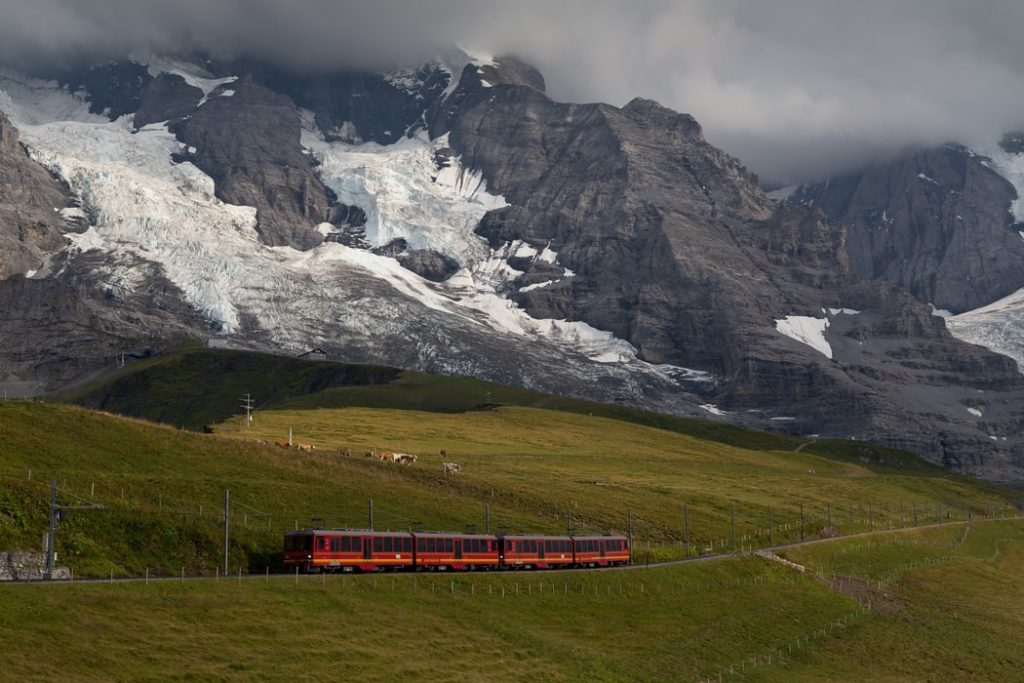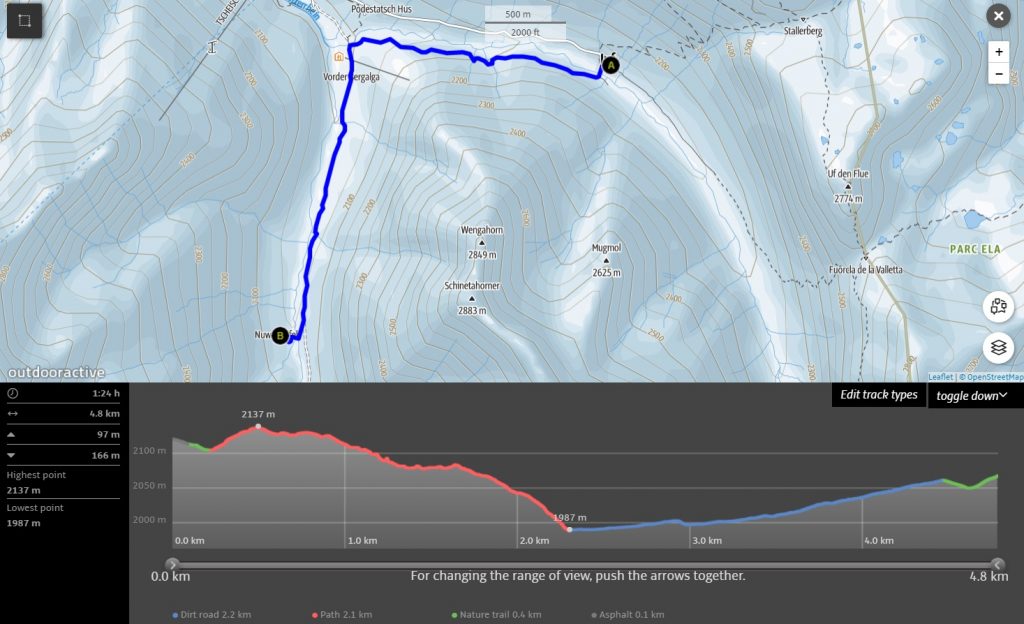If you would like to visit the highest village in Switzerland (by some information sources it is the highest in Europe) you should head to Juf. It is the highest village which is lived all year round, meaning that people don’t leave it in winter. It is sitting at 2126 meters altitude and in winter it gets really chilly up there, but don’t worry, there’s plenty to do!
It has only over 30 inhabitants, but if to compare from the older days, its population is growing, I guess more and more people love to live in such places as the internet connects you to the world. Juf doesn’t have many buildings, but most of them are very old and beautiful. After Juf there are just mountains. Nothing else.
If you’ve ever been to Iceland or some isolated Norway mountains, you will get it, that this Juf village and its surroundings remind you of that. The landscape is really beautiful. Pristine and fresh nature all year round in Juf.
Table of Contents
Where is Juf
Juf village is in Graubünden canton not that far from Italy (if you walk through mountains). Avers is the next-door village to Juf – little bigger. But the village is pretty isolated and the next big city is Chur, 64 kilometers away. Another very famous ski resort St. Moritz is not that far as well – 97 kilometers, but if we talk about bigger cities and airports, it is much further: from Zürich it is 182 kilometers, from Basel it is 269 kilometers.

Juf is situated right next Avers Rhine river (in Romansh language it would be Ragn da Ferrera). Romansh is the fourth official Swiss language mostly spoken in smaller villages in the mountains. It is very similar to the Italian and Latin mix.
If you would think of crossing the mountains in front of Juf, you would get to Bregaglia or Maloja – these are bigger settlements in the Swiss Alps.
How to Get to Juf
Juf is reachable by cars and buses.
If you decide to go in your own car, no problem. Just put JUF on your GPS and hit the road. Once you come to Juf, there are few parking lots, not big, but should be enough to leave the car. The parking is free, but just in case I would always have 5 CHF in cash if parking fees occur in the future.

Juf doesn’t have train connections but do not worry, there are bus connections every day. Just go here for the latest time schedules and prices: Swiss trains and buses. The whole trip from Zürich would take you a bit longer than 3 hours. You will get to Chur by train and then you will have to take couple of buses to reach Juf village.
What to Do in Juf
Once you come to Juf, you will feel the majesty of all the surroundings: no trees, big meadows, big mountains and only a small village in front of you. That’s a perfect escape place.
Juf has just around 20 buildings, but all of them with history. It’s a historic village featuring a real tradition from the region.
There are a couple of places to sleep and spend the night, the biggest one is this: Pension Edelweiss. There you can have a private room or spend a night in a big room with many beds, it’s almost like a Swiss mountain hut. The lowest price starts from 14 CHF. That’s very cheap. You can get breakfast over there as well. Here is all the information about the place, so you can make reservations or ask specific questions: Juf Hotel.
There’s one very small shop in Juf called Juf Lädeli, where you can get some food. There’s post as well and bus stops there.
But I think the best thing you can do in Juf, is actually hiking.
Juf is placed in the big valley and the mountains are all around, so it offers great possibilities to hike. In winter: to do some snowshoeing.
Hiking in Juf
Ok, let’s explore the different possibilities up there.
Juf is high itself so it’s a perfect opportunity to hike quite high very fast.
Here are the hiking trails:
- Juf to Piz Turba. Piz Turba is sitting at 3018 meters altitude, so a perfect opportunity to get higher than 3 kilometers.
- Juf to Piz Surpare. Another peak higher than 3 kilometers. Even higher than Piz Turba. 3078 meters.
- Juf to Alpbeizli Hinterbergalga. There’s a small restaurant where you can refresh. The easiest hike of these all.
Ok, let’s look at these hikes one by one.
Hike from Juf to Piz Turba
It is always very fun to climb over 3000 meters, you feel like you accomplished something. It is good as well, that to conquer 3000 meters peak you don’t need any specific equipment. Unless it’s rocks or something else, but this hike doesn’t need it.
I would do this hike from Mid July to September then there’s minimum levels of snow or no at all. If there’s snow: better take snowshoes or crampons.
Let’s have a look at the map of this hike:

Even though you start pretty high, you will need to climb more than 900 meters in elevation. That’s not very easy, but doable if you choose the right pace: 2-3 kilometers per hour. The hiking path is mostly very well maintained, in some places you may need to get your hands a bit dirty: to climb through rocks, but no worries, it’s not rock climbing.

The whole hike till the peak should take you up to 3 hours. Hiking back can be done in 2 hours. The overall hike is around 5 hours. Around 14 kilometers in total distance.
On the way to Piz Turba you are going to pass mountain pass Forcellina, very beautiful places. From Forcellina you have to gain around 400 meters in altitude to reach the destination.
From the peak the whole valley opens up and much more peaks are seen. Great place to take some pictures.
The hike is not very easy as you are high all the time, take at least 3 liters of water for each person and good mountain/hiking shoes with clothes. Weather can change fast and especially on the top it can get chilly even in the middle of summer.
Hike from Juf to Piz Surpare
Piz Surpare is yet another peak higher than 3000 meters. Actually around Juf there’s plenty of such high peaks.
Let’s have a look at this hike below:

One very fast note: for some reason the map didn’t show the end of the hike, Piz Surpare, it stops right before it. So you are missing a bit of elevation gain: around 200 meters and distance of few hundred meters. Sorry about that. The B point is right next to Piz Surpare, the peak name is visible.
What is very cool about this hike: you are going to see few Swiss Alps lakes, they are small, but very gorgeous. You should get a very good look to Flueseen – the lake.
The hike path has a lot of rocks on it, quite a lot of rubble, so take good shoes with you, with a thin shoe sole it can be painful to walk long distances on this surface.

Once you are on the top, the beautiful views reveal themselves. Time to rest, eat your lunch, drink your tea. The whole hike up should take you around 3 hours. Hike back: around 2 hours, so the whole hike is 5 hours. Distance: 12 kilometers. Elevation gain: 952 meters.
Hike from Juf to Alpbeizli Hinterbergalga
This one is the easiest one. It leads to another valley and in the end you can rest in mountain restaurant. It’s a small one, but still great place to be. I am very often surprised how they make such places in so isolated places, that’s amazing.
Have a look at the map:

Here you are going to walk a bit back, around 2 kilometers. If you wish, you can even start this hike in Juppa. Then it gets even shorter.
Most of the time you will lose elevation, but after a turn in Juppa you will have to hike up, but it’s no problem, you won’t really feel it that much in your calves.
Once you reach the end, I really recommend having a coffee in the restaurant up there and just head back. If you feel like hiking more, you can continue in that valley.
The whole hike back and forth shouldn’t take you longer than 3 hours. Distance: 10 kilometers. It is the longest hike in distance, but the easiest one as well.
Snowshoeing in Juf
The location and landscape is actually very good to snowshoe there, but in no way you should go that high like 3000 meters up there. Always better to be safe. In such altitudes and mountains the snow can get pretty unstable up there.
What I would do, and the safest is: to use the hiking path to Alpbeizli Hinterbergal, so it is on the same level, nothing too hard. Of course, if you see that you can go up, it’s very easy with snowshoes, it’s like offroad tires, they go anywhere. But always be aware of surroundings, avalanches come with no warning notice. Sometimes in Switzerland right next to the snowshoeing route or by the slope put the warning messages about avalanches, if you see one, don’t go there.
Another good and safe way is to go to skiing slopes in Juf, Juppa. You can walk pretty high up there (higher than 2000 meters), and there shouldn’t be worried about the avalanches (unless mentioned in the skiing resort). It is always safe to snowshoe in skiing resort. If you have those skis where you can use walking up or can attach your snowboard to the backpack – even better. You earn that ride down in the best way.
Have a look at Juf, Juppa skiing resort map. It’s a small resort, but really good to do some snowshoeing, that will be enough to burn some calories and enjoy the nature.
Conclusion
In my opinion, Juf is really a place to visit. It is the highest village where people live all-around year! It’s really a spot to be.
I really recommend visiting their official websites for even more information: Juf Avers. And this website as well: Juf Dorf.
If you come there in summer: explore those 3000 meters peaks. If you come in winter: grab your snowshoes. It’s a good place to learn skiing as well as the skiing resort is small, so no one will bump into you and you will be more relaxed while learning.
Juf – the highest village in Switzerland and Europe! Must see!
If you have any questions about Juf, please let me know, I will do my best to help you.

